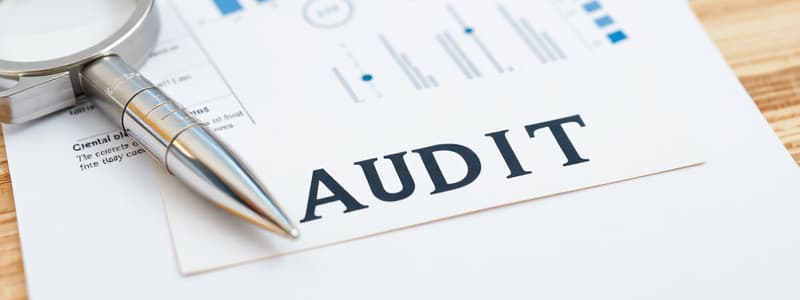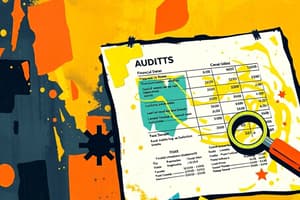Podcast
Questions and Answers
What is the primary purpose of audit evidence?
What is the primary purpose of audit evidence?
- To evaluate an auditor's performance
- To provide a justification for the auditor's fees
- To determine the validity of financial statements according to established criteria (correct)
- To perform audits as quickly as possible
Which of the following is NOT one of the four decisions an auditor must make regarding audit evidence?
Which of the following is NOT one of the four decisions an auditor must make regarding audit evidence?
- When to perform the procedures
- Whether to hire additional staff (correct)
- What sample size to select
- Which audit procedures to use
How does the sample size impact the audit process?
How does the sample size impact the audit process?
- Larger sample sizes are more likely to yield accurate results (correct)
- A larger sample size decreases the credibility of the audit
- The sample size has no effect on the audit process
- Smaller sample sizes always lead to faster audits
What is an audit procedure?
What is an audit procedure?
Which factor does NOT influence the amount and type of audit evidence collected?
Which factor does NOT influence the amount and type of audit evidence collected?
In verifying cash disbursements, what is the auditor required to examine?
In verifying cash disbursements, what is the auditor required to examine?
What is a key factor in determining the sample size for an audit procedure?
What is a key factor in determining the sample size for an audit procedure?
When might an auditor choose to increase the sample size?
When might an auditor choose to increase the sample size?
What is the primary purpose of tracing from duplicate sales invoices to shipping documents?
What is the primary purpose of tracing from duplicate sales invoices to shipping documents?
Which statement regarding the relevance of evidence is true?
Which statement regarding the relevance of evidence is true?
What enhances the reliability of evidence obtained during an audit?
What enhances the reliability of evidence obtained during an audit?
In assessing the reliability of evidence, which characteristic is NOT considered?
In assessing the reliability of evidence, which characteristic is NOT considered?
What type of evidence is considered the most reliable during an audit?
What type of evidence is considered the most reliable during an audit?
How does the effectiveness of a client’s internal controls impact audit evidence?
How does the effectiveness of a client’s internal controls impact audit evidence?
Which type of evidence would an auditor consider least reliable?
Which type of evidence would an auditor consider least reliable?
Why is evidence obtained through an auditor’s direct knowledge typically more reliable?
Why is evidence obtained through an auditor’s direct knowledge typically more reliable?
What increases the reliability of evidence in income statement accounts?
What increases the reliability of evidence in income statement accounts?
What is primarily measured by the sample size selected by the auditor?
What is primarily measured by the sample size selected by the auditor?
Which of the following factors is NOT considered when determining appropriate sample size in an audit?
Which of the following factors is NOT considered when determining appropriate sample size in an audit?
Which type of evidence is defined as the inspection or count of a tangible asset?
Which type of evidence is defined as the inspection or count of a tangible asset?
Which of the following categories is focused on verifying the existence and condition of an asset?
Which of the following categories is focused on verifying the existence and condition of an asset?
What typically warrants a larger sample size in audits?
What typically warrants a larger sample size in audits?
Which type of evidence is considered one of the most reliable and useful for verifying assets?
Which type of evidence is considered one of the most reliable and useful for verifying assets?
In auditing, which method can help ascertain both the quantity and description of an asset?
In auditing, which method can help ascertain both the quantity and description of an asset?
What is the primary determinant of the appropriateness of audit evidence?
What is the primary determinant of the appropriateness of audit evidence?
Which factor does not enhance the appropriateness of audit evidence?
Which factor does not enhance the appropriateness of audit evidence?
Why is the relevance of evidence crucial in an audit?
Why is the relevance of evidence crucial in an audit?
What does sufficiency of audit evidence refer to?
What does sufficiency of audit evidence refer to?
Which of the following statements about audit opinions is true?
Which of the following statements about audit opinions is true?
Which auditing procedure would be considered an inappropriate method for testing completeness?
Which auditing procedure would be considered an inappropriate method for testing completeness?
What is the consequence of using inappropriate evidence in an audit?
What is the consequence of using inappropriate evidence in an audit?
In an audit, which procedure is more relevant for confirming that shipments were billed?
In an audit, which procedure is more relevant for confirming that shipments were billed?
Why is client inquiry evidence generally not regarded as conclusive?
Why is client inquiry evidence generally not regarded as conclusive?
What is the primary purpose of obtaining corroborating evidence?
What is the primary purpose of obtaining corroborating evidence?
Which of the following best defines recalculation in an audit context?
Which of the following best defines recalculation in an audit context?
What distinguishes reperformance from recalculation?
What distinguishes reperformance from recalculation?
What limitation is associated with observation as a method of obtaining evidence?
What limitation is associated with observation as a method of obtaining evidence?
Why is proper planning essential for auditors before conducting an audit?
Why is proper planning essential for auditors before conducting an audit?
How does observation contribute to the audit process?
How does observation contribute to the audit process?
What is one of the reasons for keeping audit costs reasonable during the audit?
What is one of the reasons for keeping audit costs reasonable during the audit?
What is the primary purpose of analytical procedures in audits?
What is the primary purpose of analytical procedures in audits?
What information is NOT typically included in the current audit files?
What information is NOT typically included in the current audit files?
Which of the following best describes the audit program in current files?
Which of the following best describes the audit program in current files?
What key role does the working trial balance play in the audit process?
What key role does the working trial balance play in the audit process?
Which of the following documents would you NOT typically find in the general information section of current files?
Which of the following documents would you NOT typically find in the general information section of current files?
How do auditors typically ensure that the audit program is being followed during the audit?
How do auditors typically ensure that the audit program is being followed during the audit?
What are permanent files primarily used for in auditing?
What are permanent files primarily used for in auditing?
Which of the following best defines the term 'control risk' in the context of the audit?
Which of the following best defines the term 'control risk' in the context of the audit?
Flashcards
Audit Evidence
Audit Evidence
Information collected by auditors to determine if financial statements comply with established standards.
Audit Procedure
Audit Procedure
Detailed instruction explaining how to obtain audit evidence during an audit.
Sample Size
Sample Size
Number of items chosen from a total set (population) during an audit procedure.
Population
Population
Signup and view all the flashcards
Audit Procedure Example (Cash Disbursements)
Audit Procedure Example (Cash Disbursements)
Signup and view all the flashcards
Evidence Decisions (Auditing)
Evidence Decisions (Auditing)
Signup and view all the flashcards
Audit Planning
Audit Planning
Signup and view all the flashcards
Documentation
Documentation
Signup and view all the flashcards
Persuasiveness of Audit Evidence
Persuasiveness of Audit Evidence
Signup and view all the flashcards
Appropriateness of Evidence
Appropriateness of Evidence
Signup and view all the flashcards
Relevance of Evidence
Relevance of Evidence
Signup and view all the flashcards
Sufficiency of Evidence
Sufficiency of Evidence
Signup and view all the flashcards
Audit Objective
Audit Objective
Signup and view all the flashcards
Sample Selection
Sample Selection
Signup and view all the flashcards
Financial Statements
Financial Statements
Signup and view all the flashcards
Cash Disbursements Journal
Cash Disbursements Journal
Signup and view all the flashcards
Relevant Evidence
Relevant Evidence
Signup and view all the flashcards
Occurrence Transaction Objective
Occurrence Transaction Objective
Signup and view all the flashcards
Reliability of Evidence
Reliability of Evidence
Signup and view all the flashcards
Independent Evidence Provider
Independent Evidence Provider
Signup and view all the flashcards
Effective Internal Controls
Effective Internal Controls
Signup and view all the flashcards
Auditor's Direct Knowledge
Auditor's Direct Knowledge
Signup and view all the flashcards
Unbilled Shipments
Unbilled Shipments
Signup and view all the flashcards
Duplicate Sales Invoices
Duplicate Sales Invoices
Signup and view all the flashcards
Reliable Evidence
Reliable Evidence
Signup and view all the flashcards
What Determines Evidence Sufficiency?
What Determines Evidence Sufficiency?
Signup and view all the flashcards
Sample Size Factors
Sample Size Factors
Signup and view all the flashcards
Physical Examination
Physical Examination
Signup and view all the flashcards
Physical Examination: What does it confirm?
Physical Examination: What does it confirm?
Signup and view all the flashcards
Physical Examination: Reliability
Physical Examination: Reliability
Signup and view all the flashcards
Physical Examination: Applications
Physical Examination: Applications
Signup and view all the flashcards
Physical Examination: What it can reveal
Physical Examination: What it can reveal
Signup and view all the flashcards
Corroborating Evidence
Corroborating Evidence
Signup and view all the flashcards
Recalculation
Recalculation
Signup and view all the flashcards
Reperformance
Reperformance
Signup and view all the flashcards
Observation
Observation
Signup and view all the flashcards
Why is observation limited?
Why is observation limited?
Signup and view all the flashcards
Why should auditors properly plan engagements?
Why should auditors properly plan engagements?
Signup and view all the flashcards
What are the 3 main reasons for audit planning?
What are the 3 main reasons for audit planning?
Signup and view all the flashcards
Why is inquiry usually not enough?
Why is inquiry usually not enough?
Signup and view all the flashcards
Audit Program
Audit Program
Signup and view all the flashcards
Working Trial Balance
Working Trial Balance
Signup and view all the flashcards
Permanent Files
Permanent Files
Signup and view all the flashcards
Current Files
Current Files
Signup and view all the flashcards
Analytical Procedures
Analytical Procedures
Signup and view all the flashcards
Internal Control Information
Internal Control Information
Signup and view all the flashcards
Control Deficiencies
Control Deficiencies
Signup and view all the flashcards
Audit Documentation
Audit Documentation
Signup and view all the flashcards
Study Notes
Audit Evidence; Audit Planning and Documentation
- Audit evidence is the information collected by an auditor to determine the accuracy and compliance of a company's financial statements
- The evidence supports the company's financial statements and their adherence to accounting laws in their jurisdiction
- Examples of audit evidence include bank accounts, management accounts, payrolls, bank statements, invoices, and receipts
- Good audit evidence must be sufficient, reliable, and relevant
Audit Evidence Decisions
- Auditors need to determine what supporting evidence to gather and how much of it is required.
- Four important decisions to make include:
- Which audit procedures to use
- What sample size to select for a given procedure
- Which items to select from the population being tested
- When to perform the procedures
Audit Procedures
- An audit procedure details the instructions for obtaining audit evidence.
- Procedures are very specific to ensure the auditor can follow them to conduct the audit
- Example procedure: Examining the cash disbursements journal, comparing payee, name, amount, and date with online bank information of checks processed for the account
Sample Size
- Auditors can test all items or a sample from a given population.
- For example, if a cash disbursement journal has 6,600 checks, the auditor might select a sample size of 50 for comparison
- The sample size chosen depends on the procedure, client characteristics (the extent of automated controls) and the level of assurance required for the audit
Items to Select
- After determining the sample size, an auditor must choose the items from the population to be tested.
- Choices include selecting specific checks from a week, selecting the checks with the largest amounts, selecting checks randomly, or those checks the auditor thinks are most likely to be incorrect.
- These methods can be used alone or in combination
Timing
- An audit period usually covers a year. The audit isn't always completed at the end of the period.
- Client needs determine timing. Examples include:
- Public companies are required to file audited financial statements within a specific time period after their fiscal year-end (usually 60-90 days).
- Auditors often prefer to do counts of inventory close to the balance sheet date for greater reliability.
Persuasiveness of Evidence
- Audit standards require sufficient appropriate evidence to support the auditor's opinion.
- Auditors aim for a high level of assurance that the opinion is correct, but complete conviction isn't always possible.
- Two factors that affect the persuasiveness of evidence are appropriateness and sufficiency
Appropriateness of Evidence
- Appropriateness is a measure of the evidence's quality.
- It relates to how well the evidence meets the audit objectives for transactions, account balances, and related disclosures to support evidence that financial statements are fairly stated.
- The quality of the evidence can't be improved by selecting a larger sample size or a different sample. It can be improved by selecting more relevant or reliable procedures
Relevance of Evidence
- Evidence must be relevant to the auditor's testing objective.
- Example: If inventory completeness is questioned, the auditor should trace shipping documents to related sales invoices
Reliability of Evidence
- Reliability refers to evidence's trustworthiness in persuading the auditor that financial statements are fairly stated.
- Six characteristics affect reliability:
- Independence of the evidence provider
- Effectiveness of the client's internal controls
- Auditor's direct knowledge of the evidence
- Qualifications of the individual providing the information
- Degree of objectivity
- Timeliness of the evidence.
Types of Audit Evidence
- Physical examination, confirmation, inspection, analytical procedures, inquiries of the client, recalculation, reperformance, observation.
Supporting Schedules
- Detailed schedules used as evidence in the audit. Examples are analysis, trial balance, reconciliation of amounts, tests of reasonableness.
- These schedules provide support for financial statement amounts
Studying That Suits You
Use AI to generate personalized quizzes and flashcards to suit your learning preferences.




